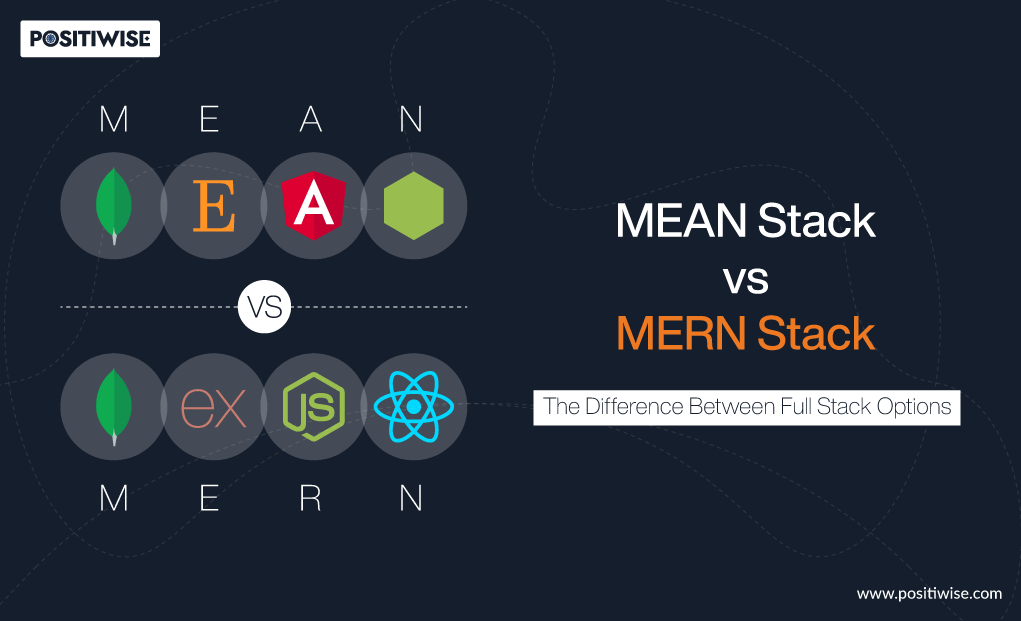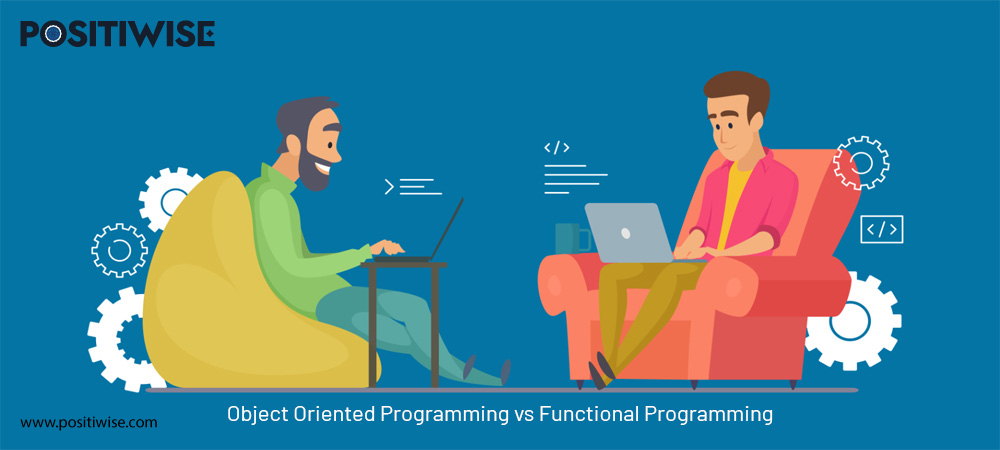Quick Overview:
Are you torn between MEAN stack vs MERN stack for your web development project? This comprehensive guide breaks down the key differences and advantages of both. MEAN (MongoDB, Express, Angular, Node.js) and MERN (MongoDB, Express, React, Node.js) are popular choices, but which is right for your project? We’ll delve into the strengths and weaknesses of each stack, highlighting factors like ease of learning, scalability, and community support. By the end of this article, you’ll clearly understand which stack aligns best with your development goals.
What is MERN Stack?
It is an open-source stack of technologies classified under the full stack. MERN Stack covers each aspect of a business solution development, from furnishing the structure to deploying it on a server. MongoDB, Express.js, ReactJS, and Node.js are the primary technologies included in this stack for producing hybrid web and mobile applications. Furthermore, this stack includes all JavaScript-based technologies that seamlessly iterate the software lifecycle.
Advantages of using MERN Stack
- Ample community support with the availability of templates and pre-developed codebases for mobile applications.
- Built-in tools for testing every business software component to discover and mitigate loopholes.
- The software efficiently supports the creation, maintenance, and advancement of code for the overall software using the Model View Controller architecture.
- Employers can hire JavaScript and JSON experts to work with this technology stack.
- Developers leverage React libraries to integrate third-party APIs and plugins, extending app functionalities.
- We cover everything, from designing the interface to creating and adjoining the databases.
What is MEAN Stack?
MEAN Stack comprises MongoDB, Express.js, Angular, and Node.js technology, and full-stack professionals utilize all these to produce robust mobile and web solutions. It is an open-source, JavaScript-based framework and platform, enabling developers to integrate third-party tools without configuring extra libraries flawlessly.
Advantages of using MEAN Stack:
It provides a solid, consistent, high-performance full-stack framework for building web applications using flexible open-source technologies. The shared use of JavaScript is a big advantage.
- JavaScript Everywhere: It uses JavaScript for front-end, back-end, and database. This makes development seamless and consistent.
- Open Source: All components in this stack are free open-source technologies. This avoids vendor lock-in.
- Speed: Node.js and MongoDB provide extremely high performance, making it very fast.
- Flexibility: Components like Express and MongoDB are flexible and easy to integrate. It can be adapted to many use cases.
- Fullstack for Web: The stack contains everything needed to make a modern, interactive web application. Perfect for web developers.
Build Your Business with Custom .NET Application Development Services
Take your business online with custom ASP.NET app development services. Our top .NET developers deliver secure, scalable web applications to grow your enterprise business.
The Key Difference: MEAN Stack vs MERN Stack
Before selecting any technology stack for building an enterprise-grade solution, one should constantly evaluate it on the below-listed basis. It will ensure a long-lasting application providing edge-to-edge services to all the stakeholders.
- Performance
- Security
- Third-Party Integrations
- Data Flow
- Support for MVC
- Code maintenance and Advancement
- Mobile App Creation
- CRUD Applications
- Fewer Errors
Performance
Selecting the right technology for building software achieves the primary objective of any application: fast, smooth, and accurate execution of user requests.
- MEAN Stack utilizes the Angular Framework, which functions upon the accurate Document Object Model.
- MERN Stack employs the React Framework, which deploys updates in the virtual DOM, enabling faster operation performance compared to Angular.
Additionally, apps created using MERN Stack are lightweight, and developers are free from defining state transitions, boosting performance.
Security
Crafting a secure application structure for handling and maintaining data integrity is a top-level priority, and technologies included in the MEAN Stack vs MERN stack fulfill it. The primary difference between these stacks is the Angular and React framework, and both offer advanced incorporated security modules. In addition, these applications use MongoDB, which prevents SQL injection attacks and ensures the confidentiality of the stored data in the communication channel.
But, in scaling up the security mechanisms with external tools and APIs, the MEAN stack is more compatible.
Third-Party Integrations
To extend the traditional functionalities of applications, developers integrate external tools, APIs, plugins, libraries, virtual machines, and widgets. For enabling the encrypted data transmission using SSL, modules for supporting HTTPS should also be present in the installation package. It requires third-party components to enable the same functionality that the angular framework provides with its built-in HTTPS installation and configuration functions.
Moreover, It provides an effortless way to add and remove any externally sourced services, such as Cloud, without affecting other modules, just like a plug-and-play mechanism. MERN technologies require additional configurations for similar purposes.
Data Flow
MEAN follows a bidirectional approach, and MERN follows a unidirectional for flowing the data within the different application components. Each stack considers a specific type of application with its contrasting data flow mechanism.
- It is utilized for large-scale projects that require extensive data processing.
- MEAN is highly regarded for small and medium software applications.
In the bidirectional flow of Angular, the user interface and model state are linked, as any modification in the UI automatically changes the state. In comparison, it eliminates it through unidirectional flow and offers to craft an optimized data processing channel.
Support for MVC
The Model-View-Controller (MVC) architectural pattern offers several technical advantages in software development. It facilitates faster development by segregating concerns, supports test-driven development (TDD) practice, and enables developers to employ asynchronous method invocation for ease of modification. In the context of enterprise-level application development, MEAN stack, a technology stack encompassing MongoDB, Express.js, Angular, and Node.js, is commonly utilized to implement the MVC architecture.
This approach promotes a focused and modular approach to software development, allowing developers to address each layer (Model, View, and Controller) individually. It results in a more organized and efficient codebase, ultimately leading to improved software functionality and maintainability.
Code maintenance and advancement
With a briskly evolving market, businesses must modernize their applications accordingly.
- As MEAN stack-based solutions follow the MVC approach, developers can differentiate between the back-end and front-end code. As a result, any back-end code change doesn’t degrade the code written for the interface and vice-versa.
- MERN stack developers need to resolve the complexities of third-party embedded APIs and tools before performing any advancement.
Mobile App Creation
Along with websites and web apps, mobile applications are necessary for reaching out to the targeted audience. Developers can fabricate a robust mobile application with Angular and React, but it depends upon the business demands while picking out the tech stack. If your business needs a hybrid application for iOS and Android users, then MEAN is the perfect fit, as Angular offers its Ionic framework for such development.
Further, if you want to provide a native experience to the user, MERN will be the perfect fit for innovating an appealing mobile app.
CRUD Applications
CRUD stands for Create, Read, Update, and Delete, and these apps are used to prevent casual browsing and perform database operations with ad hoc SQL statements. The development team utilizes MERN for fabricating CRUD applications due to the incorporation of ReactJS for managing dynamic modifications in data and interface. In addition, if your organization needs a single-page application, the MEAN stack is the right choice.
Fewer Errors
Typescripts are utilized while creating Angular-based software, and it is more effective in spotting bugs and errors in the early stages. Moreover, with fast refactoring and IDE support, one must go for the MEAN stack to reduce glitches and vulnerable loopholes in the business solution.
Head-to-Head Comparison
| Aspect | MEAN Stack | MERN Stack |
|---|---|---|
| Definition | MEAN is a full-stack JavaScript framework that comprises MongoDB, Express.js, Angular, and Node.js. | MERN is a full-stack JavaScript framework that includes MongoDB, Express.js, React, and Node.js. |
| Front-end Library | Angular | React |
| Back-end Language | JavaScript | JavaScript |
| Database | MongoDB | MongoDB |
| Server-side Framework | Express.js | Express.js |
| Front-end Framework | Angular | React |
| Community and Support | Well-established community and extensive documentation. | Strong community support and vast resources are available. |
| Learning Curve | There is a Steeper learning curve due to the complexity of Angular. | React is easier to learn, making it more accessible for beginners. |
| Flexibility and Scalability | Angular is a robust framework suitable for large-scale applications. | React provides more flexibility, allowing developers to choose additional libraries and customize the stack. |
| Real-time Applications | Slightly less suitable for real-time applications compared to React. | React’s virtual DOM makes it highly efficient for real-time applications. |
| SEO-Friendly | Requires additional effort to implement server-side rendering for SEO purposes. | React’s server-side rendering capabilities make it more SEO-friendly out of the box. |
| Popularity | It is popular but has seen a slight decline in recent years. | Highly popular and widely used for web development. |
Overview of Full-Stack Development
Full-stack development refers to a specific set of programming languages, databases, platforms, and frameworks utilized by full-stack developers to craft overall software. In simple terms, a single developer performs both back-end and front-end development using compatible technologies. Full-stack experts complete all the procedures, including API integration, adjoining the database, and server installation, to eliminate the drawback of incompatibility between modules from different technologies during development.
Most organizations prefer an individual skilled in one of the domains, whether back-end or front-end. However, businesses are considering a single technology stack that includes tools for constructing highly scalable and platform-independent applications to meet modernizing business requirements.
Which One Should You Choose?
The popularity and use of MEAN stack vs MERN stacks are increasing. Daily, more and more organizations are opting for these full-stack development sets of technologies to build their software. In addition, students and professionals in the IT industry are also coming forward to learn frameworks in these stacks to advance their careers, as the main difference between these stack is Angular and React frameworks.
But, as we analyze the upcoming tech trends, learning the MERN stack will benefit experts creating web apps more. Moreover, students and freshers aspiring to work in the development domain can also start and grow their careers by getting hands-on with the stack. Furthermore, enterprises must consider and evaluate their requirements with the features of these stack before picking out any one of them for a software project. Also, with the above-provided MEAN stack vs MERN stack difference, you can quickly pick out a suitable set of technologies for constructing a cutting-edge business application.
Expert in Marketing Strategy and Brand Recognition
Jemin Desai is Chief Marketing Officer at Positiwise Software Pvt Ltd, he is responsible for creating and accelerating the company’s marketing strategy and brand recognition across the globe. He has more than 20 years of experience in senior marketing roles at the Inc. 5000 Fastest-Growing Private Companies.




